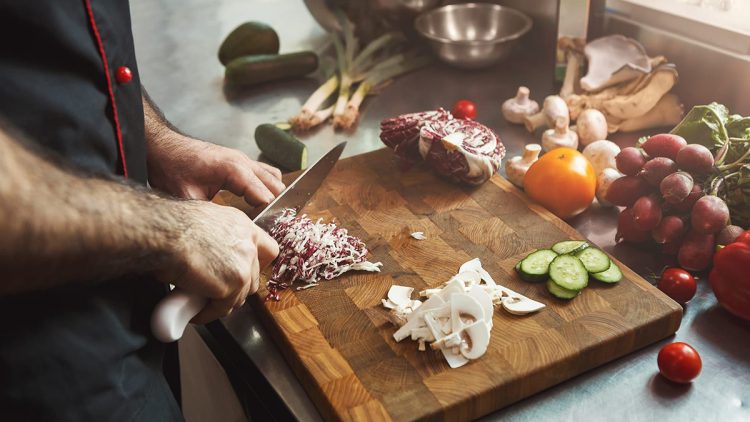From paring and slicing strawberries to top your morning bowl of yogurt and granola to tearing into a grilled juicy brined pork chop at dinner, you’d be hard-pressed to go through any meal prep without reaching for a knife.
Whether you are shopping for your basic first set or upgrading to a block that will be the envy of all your epicurean friends, here’s how to find ones that are a cut above.
Start Simple
Going all in on a huge block might not be the right decision — at least at first, says Ken Rubin, chief culinary officer at Rouxbe, an online culinary school with 540,000 students worldwide.
“The best thing to do is start with one great knife, the one that you will reach for 95% of the time,” he says. “For most of us that is a chef’s knife, likely 7-9 inches in length with a ‘full-tang’ design for integrity and weight from the blade through the handle.”
Those criteria will be the same whether you live alone, are part of a couple or are cooking for an entire family, he adds. And keep in mind that a knife is not going to make you cut better–that requires practice or a knife skills course. Select one based on your budget and how comfortable it feels–ideally like an extension of your hand.
Try:
- Wüsthof 8-inch Cook’s Knife ($84.95): The German knife maker has cook’s knives at different price points, and this one is versatile and affordable, which touts a sharp and easily-maintained laser-cut blade and a highly-durable POM handle that resists fading and discoloration.
- Misen 8-inch Chef’s Knife ($65), a sleek and versatile option combining Western- and Japanese-style blades.
- MAC MTH-80 8-inch Chef’s Knife with Dimples ($175), the company’s most popular knife for everyday use, with a thin 2.5mm blade and dimples to help glide through sticky foods like potatoes.
Get The Essentials
Any knife set from a starter to a professional should have a chef’s knife, paring knife and serrated bread knife, according to Adam Fischer, vice-president at Wüstof.
“These three knives cover almost all tasks and are a must-have in your kitchen arsenal,” he says.
Each of them is a multi-tasker: the saw-like serrated edge can cut through a crusty loaf as well as a lemon, the paring knife peels, minces and dices and the aforementioned chef’s knife is the one you’ll reach for again and again. Some sets swap out the serrated knife for a utility knife, so when shopping for one think about what you usually end up preparing or serving.
Try:
- WüsthofGourmet Starter Set ($129.95), a three-piece set of high-carbon stainless steel knives with a 4 ½-inch utility knife, 8-inch bread knife and 8-inch cook’s knife.
- Zwilling J.A. Henckels Twin Signature 3-Piece Starter Knife Set ($188), manufactured in German with high-carbon stainless steel, the set includes a 4-inch paring knife, 6-inch utility knife and 8-inch chef’s knife.
- Shun Premier 3-Piece Knife Starter Set ($557 suggested retail price), hand-crafted in Japan with thin and lightweight blades, the set includes a 4-inch paring knife, 6 ½-inch utility knife and 8-inch chef’s knife.
Curate Your Own Collection
“I typically resist the idea of buying an entire knife block or set because I’m not really brand loyal that way,” Rubin says. “I might love a certain serrated knife but not particularly care for the paring knife in that same set.”
If you prefer different styles from different companies you can always buy an empty knife block that holds a handful or many knives and stock it over time. Or eschew the block altogether and go for a magnetic knife strip on your backsplash.
Meat lovers will want to add steak knives to slice through that marbled rib eye, seafood fans will find a deboning and filleting knife to be indispensable for that Faroe Island salmon and you can even purchase a knife specifically-designed for cutting those ripe summer garden tomatoes.
Cater To The Home Cook
A home cook’s knife needs absolutely vary based on demographics, Fischer points out.
“If a household does not cook often, they likely don’t need a 16-piece knife block set,” he says. “On the reversal, a household that cooks often and is inventive in the recipes they tackle often should have a multitude of knives at the ready to handle any task.”
So he might recommend a 7-piece block for a couple living together, all the way up to a 22-piece block for expert home chefs looking to up their culinary game. No matter the set, families with small children will want to store knives out of reach in in-drawer inserts rather than on the counter top.
Try:
- J.A. Henckels International Statement 15-Piece Knife Block Set ($350 suggested retail price), a lightweight option with five prep knives, a set of 6 steak knives, sharpening steel, kitchen shears and a hardwood block.
- Wüsthof Epicure 7-Piece Block Set ($549.95), with five essential knives as well as kitchen shears and an acacia block
- Wüsthof 22-Piece Mega Block Set ($1,799.95), the ultimate set with 12 knives for prepping, a set of 8 steak knives, kitchen shears and a 22-slot block.
You Made An Investment: Take Care Of It
Follow the manufacturers’ instructions, but hand-washing is usually recommended to maintain sharpness and prevent handles and rivets from being damaged from the cleaning agents or heat of a dishwasher, Rubin says.
But, knives must be washed and then died immediately rather than soaking, Fischer advises, so they don’t get rusty. Don’t reach for knives for non-food items like boxes or very hard or brittle foods like animal bones, and avoid the temptation to use knives as a screwdriver, which can break off the tip.


Great post!! It will help to choose knives for different purposes. Very informative and helpful post. Thanks for sharing!